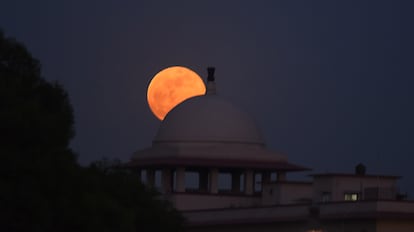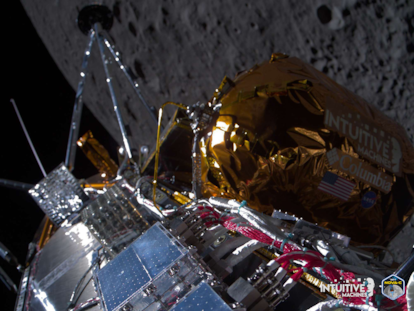Why does the moon sometimes look large and orange?
There are two moments in which Earth’s satellite appears to be a different, more reddish, color

The question of why the moon sometimes looks larger than usual, and a different color, is not a simple one because there are many ramifications. First, there is the perception of color, which is real. Sometimes the moon appears to be a deep orange, and sometimes even red. It looks orange when it is on the horizon and that is very simple to explain. For the same reason the Sun appears more orange at sunrise and sunset. This is due to a phenomenon called Rayleigh scattering. The atmosphere is full of small molecules that scatter light differently depending on the color of that light. The bluer light, which has a shorter wavelength, scatters in all directions. But red (or orange) light, which has a longer wavelength, is able to travel longer distances through those particles and reach us. This is also why the sky appears to be blue.
When there is a lunar eclipse, we can also observe this phenomenon, even though it is in the sky and not on the horizon. In this case, the light is passing through the Earth’s atmosphere, which is in between. In a lunar eclipse, the Earth blocks the Sun’s rays reflecting off the surface of the moon. The blue light that passes through the Earth’s atmosphere is dispersed in all directions, so it does not reach the surface of the moon, but the redder light does because it is not dispersed as much and that is why we see the moon in that color.
In short, there are two occasions on which the moon appears in a different, more reddish, color. One is when it is on the horizon and another is during a lunar eclipse. But the amount of suspended dust in the atmosphere can also cause us to see orange moons or Suns, for example, in haze or if there are large fires.
In terms of size, large moons are always an optical illusion. On the same night of a full moon, for example, the distance between our satellite and us does not change: we see it appear in the east and set in the west. And yet, we perceive that it is very large when it is on the horizon line, and smaller when it is above our heads. What happens is that when it is on the horizon line, it is normal for us to have some point of reference: a tree, a mountain, a building... That is why it seems very big to us. However, when it is higher up it seems smaller because we have nothing to compare it to. But it is very easy to confirm that it is the same size: you can take a photograph with the same zoom at both moments, or compare it with your fingernail. If we measure it, the size remains exactly the same. And this is so because the distance between the moon and the Earth does not change in one night. The size is exactly the same because the distance is the same. It is believed that this difference in appreciation is an effect of how our brain processes distances when it is presented with a very distant object and has to look for a closer object as a reference.
That is to say, we know that its size is the same and we also know that when we look at it at those different times it seems to us that it is not, but we still do not understand exactly why this happens.
Perhaps you have heard of supermoons. Although it is a term that is not accepted by the International Astronomical Union, which is in charge of naming and classifying celestial objects, it is quite popular. The moon’s orbit is not circular, it is elliptical. That means that at times it is closer to the Earth than at others, and the difference in distance is considerable. The shortest distance is 330,000 kilometers (205,052 miles), called perigee, and the longest, apogee, is about 407,000 kilometers (252,898 miles). The moment when the moon is closest to the Earth does not always coincide with the full moon, but when it does, it is called a supermoon. Although it is important to remember that at that moment it does not appear to be bigger — a professional telescope would be needed to measure the difference in size but with the naked eye it looks the same as always.
Eva Villaver Sobrino is a doctor in astrophysics, director of the Office of Space and Society at the Spanish Space Agency and research professor at the Astrophysical Institute of the Canary Islands.
Coordination and writing: Victoria Toro.
This article is part of an initiative sponsored by the Dr. Antoni Esteve Foundation and the program L’Oréal-Unesco ‘For Women in Science’ to answer readers’ questions about science and technology. This question was sent in by Rosario Valenzuela Generoso.
Sign up for our weekly newsletter to get more English-language news coverage from EL PAÍS USA Edition
Tu suscripción se está usando en otro dispositivo
¿Quieres añadir otro usuario a tu suscripción?
Si continúas leyendo en este dispositivo, no se podrá leer en el otro.
FlechaTu suscripción se está usando en otro dispositivo y solo puedes acceder a EL PAÍS desde un dispositivo a la vez.
Si quieres compartir tu cuenta, cambia tu suscripción a la modalidad Premium, así podrás añadir otro usuario. Cada uno accederá con su propia cuenta de email, lo que os permitirá personalizar vuestra experiencia en EL PAÍS.
¿Tienes una suscripción de empresa? Accede aquí para contratar más cuentas.
En el caso de no saber quién está usando tu cuenta, te recomendamos cambiar tu contraseña aquí.
Si decides continuar compartiendo tu cuenta, este mensaje se mostrará en tu dispositivo y en el de la otra persona que está usando tu cuenta de forma indefinida, afectando a tu experiencia de lectura. Puedes consultar aquí los términos y condiciones de la suscripción digital.











































